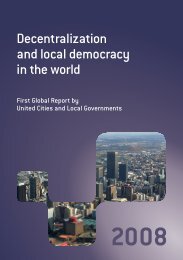Making Cities Resilient Report 2012
Making Cities Resilient Report 2012
Making Cities Resilient Report 2012
Create successful ePaper yourself
Turn your PDF publications into a flip-book with our unique Google optimized e-Paper software.
CHAPTER 4 | What are local governments doing to build resilience<br />
4. Infrastructure Protection, Upgrading<br />
and Resilience<br />
Essential 4: Invest in and maintain critical infrastructure that reduces risk, such as flood drainage, adjusted<br />
where needed to cope with climate change.<br />
Many municipalities are addressing flood risk through infrastructure and engineering projects. Albay<br />
Province and Makati City; Colombo; Mumbai; Bangkok; Cairns; Venice; Santa Fe, Argentina; Thimphu; and<br />
Kisumu all report activities to improve the capacity of drains and control of flood waters. In Siquirres, the<br />
municipality has invested in small-scale yet high-impact interventions--concrete reinforcement of the<br />
creek embankment to prevent flooding of nearby houses and expansion of underground water pipes to<br />
avoid overflow along roads. This has greatly reduced the impact of annual flooding and was completed<br />
with a small budget using resources from private sector and communities (see more in Box 1.1). Santa<br />
Fe, Argentina, has introduced water-pumping technology to improve city drainage and help to mitigate<br />
flooding (54).<br />
In an effort to become more resilient to intense rainfall events, such as the July 2005 storm where the<br />
equivalent almost 35 per cent of annual rainfall occurred in one single day, Mumbai has developed a largescale<br />
multi-action programme to tackle flood risks. This includes infrastructure investment in a storm<br />
water drainage system, widening and deepening existing water channels and causeways, rehabilitation<br />
of old drains especially in the Island City, providing smooth transition for waterways near bridges, the<br />
installation of nine storm water pumping systems and 196 discharge pumps, as well as portable dewatering<br />
pumps for use at flooded spots. There are also major annual investments in de-silting of the system. (See<br />
Box 3.2 on Venice for another example.)<br />
Box 4.7 : Bonn collaborates on climate adaptation, biodiversity and water<br />
quality.<br />
Bonn, Germany was the first city to sign on to the <strong>Making</strong> <strong>Cities</strong> <strong>Resilient</strong> Campaign, when it launched<br />
in the city in May 2010. Since then, Bonn’s Mayor Jürgen Nimptsch, says the city has made considerable<br />
progress in developing its network of partners, raising awareness of disaster risk in communities, and<br />
further engaging with national governments to recognise and support disaster risk reduction. The city is<br />
also participating in knowledge exchange programmes to share experiences, early warning, and disaster<br />
management approaches and solutions to natural hazards and climate change impacts.<br />
Bonn is working with six project partner cities worldwide, including Bukhara (Uzbekistan), Chengdu (China);<br />
Cape Coast (Ghana), La Paz (Bolivia), Minsk (Belarus) and Ulaanbataar (Mongolia). These cities are also<br />
cooperating on climate adaptation, biodiversity and water quality projects.<br />
Locally speaking, effects of climate change in Bonn—heat waves and heavy rains—have been minor.<br />
The city’s primary challenge, disaster-wise, is flooding from the Rhine River. The municipality has a very<br />
strong role and responsibility—and a legal obligation—to mitigate and reduce flood risk. The Building<br />
Department is responsible for the technical aspects related to Rhine floods and heavy rains, while disaster<br />
management is in the hands of the fire department and cooperating national governmental organisations.<br />
Measures to upgrade flood-protection in Bonn-Beuel may serve as an example. In total, €6.5 million were<br />
invested to protect a 1,000-meter-long section of the river. The state government (North Rhine Westphalia)<br />
provided €3.6 million of these funds.<br />
<strong>Making</strong> <strong>Cities</strong> <strong>Resilient</strong> <strong>Report</strong> <strong>2012</strong> | 51

















